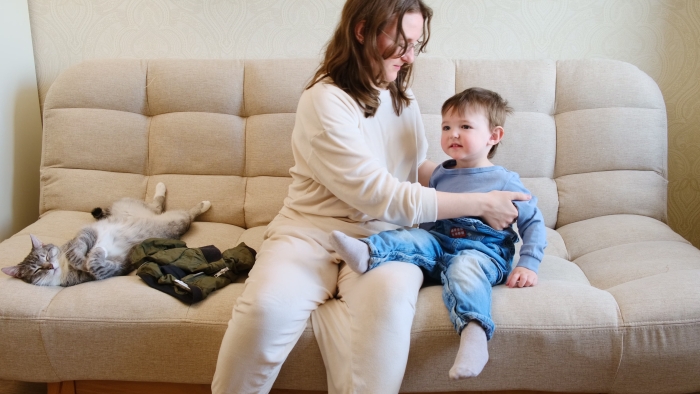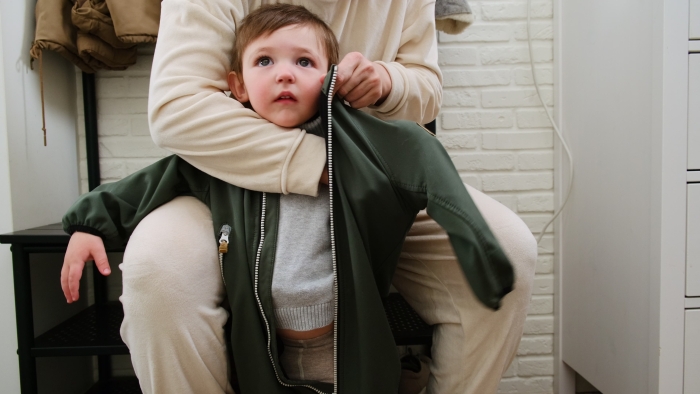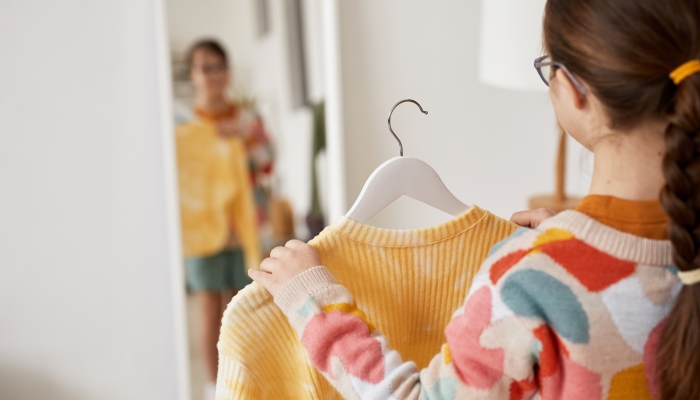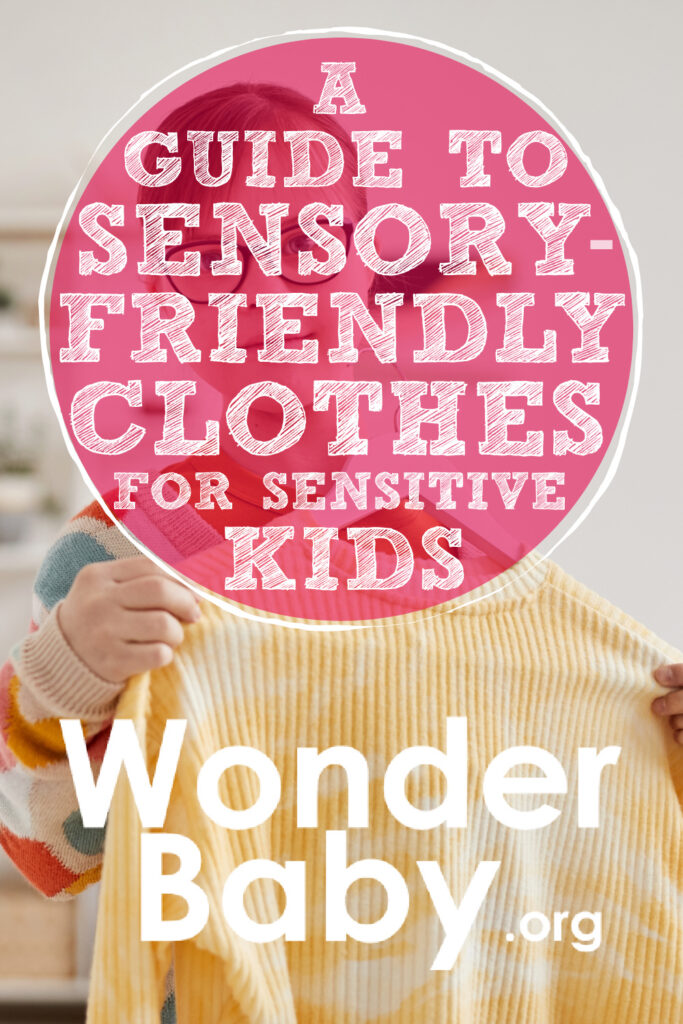A Guide to Sensory-Friendly Clothes for Sensitive Kids

This post may contain affiliate links; please see our terms of use for details.
- Sensory-friendly clothing is gentle on sensitive skin and allows your child to feel unrestricted as they go about their day.
- Children with sensory processing differences prefer adaptive clothing, which frequently is super soft and less restrictive than regular clothing.
- Specific brands of sensory-friendly clothing offer abdominal access, allowing for easy diaper changes.
If you’ve ever navigated the kid’s clothing section, you know it can be hard to find the perfect outfit for your child. As a kid, I only wore drop-waist dresses, and my mom was always hunting for them while growing a few gray hairs.
As a parent, I understand the stress my mom felt finding something comfortable that I would wear. Kids’ clothing isn’t as simple as you think, but we also want our children to feel comfortable, especially if they have sensory sensitivities.
If you are looking for information about sensory-friendly clothes, you’ve come to the right place. We’ve outlined the top qualities of sensory-friendly clothing and a few of our favorite brands.
What Are Sensory-Friendly Clothes?

Sensory-friendly clothes are created with sensory processing differences in mind. Some kids are sensitive to tight, itchy, or heavy clothing, making it challenging to find appropriate clothing.
Here’s a snapshot of the differences you’ll find when shopping for sensory-friendly clothing versus regular clothing.
| Qualities of Sensory-Friendly Clothes | Qualities of Regular Clothing |
| Tagless | Usually has tags |
| Ultra-soft fabrics | Thick fabric |
| Stretchy waistband | Tighter waistband |
| Flat seams or seamless | Interior seams |
The top fabrics of sensory-smart clothing include spandex, compression, and cotton. You may also consider weighted clothing if your child prefers compression clothing.
What Are the Benefits of Sensory-Friendly Clothes?
A sensory-seeking child benefits from sensory-friendly clothing because they are more likely to have a heightened awareness and response to sensory stimulation.
Sensory-seeking behavior is not unusual in children and includes a desire to touch everything, engage in repetitive motion, or put everything in their mouth.
Additional benefits of sensory-friendly clothing include:
- Reduces itchiness
- More comfortable
- Super soft fabric
- Reduces anxiety
- Easy to wear
If your child exhibits sensory-seeking behavior, you can try calming or stimulating sensory activities to help with overstimulation.
Why Do Some Kids Have Sensory Issues With Clothing?

Children with sensory issues are more likely to have a problem with sensory input, which is the information our brain receives from our senses. Sensory-seeking children require additional sensory input for their brains to register the information.
Some children will avoid types of input due to feeling overwhelmed, which is frequently seen in children with sensory issues with clothing.
There are several reasons why some kids have sensory issues with clothing, including:
- Some kids can’t stand annoying seams that feel uncomfortable against their skin.
- Certain fabrics can cause a sensory overload for children and make them feel overwhelmed.
- Children with sensory processing differences are more likely to be hyper-aware of the touch sensation on their body, which is referred to as tactile sensitivity.
- Uncomfortable t-shirts and pants can cause pain, burning, or an itchy sensation for children with sensory sensitivities.
How Do Sensory-Friendly Clothes Help a Kid With Sensory Sensitivities?
We all want to be comfortable in our clothes, but it goes one step further for children with sensory sensitivities.
A 2021 study published in the Journal of Autism and Developmental Disorders11. Kyriacou, C., Forrester-Jones, R., & Triantafyllopoulou, P.. Clothes, Sensory Experiences and Autism: Is Wearing the Right Fabric Important? Journal of Autism and Developmental Disorders. 2021;53(4), 1495–1508. https://doi.org/10.1007/s10803-021-05140-3 found that certain fabrics can impact an individual’s reported well-being, with the participants stating they were constantly aware of what they were wearing.
The study titled, Clothes, Sensory Experiences, and Autism: Is Wearing the Right Fabric Important? noted that by understanding tactile defensiveness, society could move towards increasing autism-friendly approaches with appropriate fabrics.
If your child is uncomfortable with what they are wearing, they may be more likely to act out or experience sensory overload.
Tips When Shopping for Sensory-Friendly Clothes

Getting ready to go shopping for your child? Here are our top tips when shopping for sensory-friendly clothing:
Go for Tagless Labels
Tagless labels are a lifesaver when looking for comfortable clothing for your child. My daughter prefers tagless dresses because they don’t bother her neck and provide extra comfort.
In addition, itchy tags are nobody’s friend, but for a child with sensory needs, they can be a deal breaker. If you can’t find tag-free options in your child’s favorite brand, you can cut the tags, but be sure you don’t leave any behind.
Look for Comfortable Socks
It’s easy to forget about finding socks If you are looking for sensory-friendly clothing, but many special needs children don’t like uncomfortable socks. You’ll want to find soft socks that are hemless and seamless, providing a comfortable fit.
I highly recommend SmartKnitKids Seamless Sensitivity Socks because they feature no seams, a heel-less design, and have non-binding sock tops. The patented seamless socks are great for kids who require sensory-sensitive clothing.
- TRULY SEAMLESS – Completely free of seams, this product is knit like a caterpillar spins its cocoon from the toe up, eliminating all lumps & bumps and providing a comfortable fit.
- SOFT & FORM-FITTING – The stretchy yarns result in a form-fitting design that eliminates wrinkling and bunching at the toes, making it great for children with sensory issues.
- COMFORTABLE, NON-BINDING TOP – The non-binding Halo Top means no slipping down or irritating indentions on the ankle.
- GOODBYE STINKY FEET – High-tech fibers remove perspiration, ensuring a drier sock & therefore preventing stinky feet.
Remember Bathing Suits
If your children enjoy swimming, you’ll want to remember to look for comfortable bathing suits. For example, you may opt for swim trunks with an elastic band and an adjustable waist.
It’s easy to forget to consider bathing suits when shopping for sensory-friendly apparel, but a comfortable suit will make summertime more fun.
Find Comfortable Underwear
Special needs parents agree that finding super soft underwear is a good idea, ensuring your child is comfortable. The best sensory-friendly underwear is free of seams and tags, offering an all-over comfortable fit.
Try Different Brands
Sometimes you have to experiment when shopping for little ones, but thankfully most brands have generous return policies. However, once you find a brand your child likes, you’ll want to stock up on their favorites!
It’s also best to remember their size when shopping for your child. For example, if your child doesn’t like tight-fitting clothing, consider sizing up. However, you will want to make sure they aren’t too baggy, where they interfere with mobility.
Top Sensory-Friendly Clothing Brands

Sensory-friendly clothing brands have special features to ensure children feel comfortable in their clothes. In addition, the stylish clothing comes in various graphics and patterns but is also soft and easy to wear.
While there are plenty of brands on the market, here are a few that strive to offer sensory-friendly clothing:
Kozie Clothes is one of my top picks because it was started by a pediatric occupational therapist with a certification in sensory integration. The brand offers therapeutic clothing made with a four-way stretch, offering gentle, deep pressure to help ease anxiety.
In addition, Target’s Cat & Jack has unique adaptive clothing designed specifically for abdominal access, making it functional, easier to access, and sensory-friendly.
Reference
- Kyriacou, C., Forrester-Jones, R., & Triantafyllopoulou, P. (2021). Clothes, Sensory Experiences and Autism: Is Wearing the Right Fabric Important? Journal of Autism and Developmental Disorders, 53(4), 1495–1508. https://doi.org/10.1007/s10803-021-05140-3

Related Posts

Eye Conditions and Syndromes, Visual Impairment
Neuralink Announces Plans to Restore Sight to the Blind with Brain Chip
Elon Musk’s company Neuralink has announced plans to begin human trials of its new “Blindsight” brain chip by the end of 2025.

Special Needs
5 Spring Cleaning Tips for Families of Children with Disabilities
Spring cleaning is an opportunity to create a more accessible, organized, and supportive space for your child with disabilities. Declutter, deep clean, and refresh!

Visual Impairment
The Gift of Understanding: How a Young Child Helps His Blind Father Navigate Life
When a parent is blind, it’s natural for people to wonder how their sighted child will adapt. Will they struggle to understand their parent’s needs? Will they feel burdened by...
